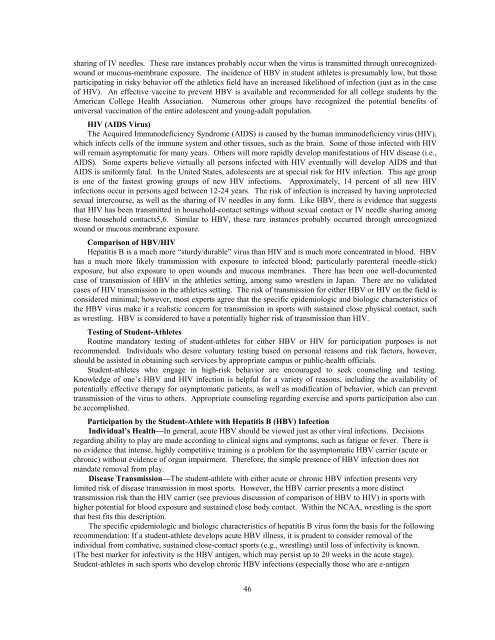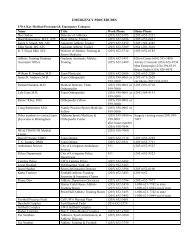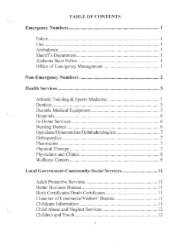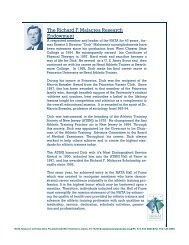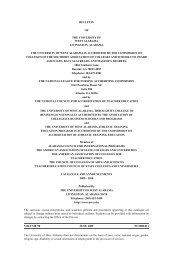table of contents - UWA Athletic Training & Sports Medicine Center
table of contents - UWA Athletic Training & Sports Medicine Center
table of contents - UWA Athletic Training & Sports Medicine Center
You also want an ePaper? Increase the reach of your titles
YUMPU automatically turns print PDFs into web optimized ePapers that Google loves.
sharing <strong>of</strong> IV needles. These rare instances probably occur when the virus is transmitted through unrecognizedwoundor mucous-membrane exposure. The incidence <strong>of</strong> HBV in student athletes is presumably low, but thoseparticipating in risky behavior <strong>of</strong>f the athletics field have an increased likelihood <strong>of</strong> infection (just as in the case<strong>of</strong> HIV). An effective vaccine to prevent HBV is available and recommended for all college students by theAmerican College Health Association. Numerous other groups have recognized the potential benefits <strong>of</strong>universal vaccination <strong>of</strong> the entire adolescent and young-adult population.HIV (AIDS Virus)The Acquired Immunodeficiency Syndrome (AIDS) is caused by the human immunodeficiency virus (HIV),which infects cells <strong>of</strong> the immune system and other tissues, such as the brain. Some <strong>of</strong> those infected with HIVwill remain asymptomatic for many years. Others will more rapidly develop manifestations <strong>of</strong> HIV disease (i.e.,AIDS). Some experts believe virtually all persons infected with HIV eventually will develop AIDS and thatAIDS is uniformly fatal. In the United States, adolescents are at special risk for HIV infection. This age groupis one <strong>of</strong> the fastest growing groups <strong>of</strong> new HIV infections. Approximately, 14 percent <strong>of</strong> all new HIVinfections occur in persons aged between 12-24 years. The risk <strong>of</strong> infection is increased by having unprotectedsexual intercourse, as well as the sharing <strong>of</strong> IV needles in any form. Like HBV, there is evidence that suggeststhat HIV has been transmitted in household-contact settings without sexual contact or IV needle sharing amongthose household contacts5,6. Similar to HBV, these rare instances probably occurred through unrecognizedwound or mucous membrane exposure.Comparison <strong>of</strong> HBV/HIVHepatitis B is a much more “sturdy/durable” virus than HIV and is much more concentrated in blood. HBVhas a much more likely transmission with exposure to infected blood; particularly parenteral (needle-stick)exposure, but also exposure to open wounds and mucous membranes. There has been one well-documentedcase <strong>of</strong> transmission <strong>of</strong> HBV in the athletics setting, among sumo wrestlers in Japan. There are no validatedcases <strong>of</strong> HIV transmission in the athletics setting. The risk <strong>of</strong> transmission for either HBV or HIV on the field isconsidered minimal; however, most experts agree that the specific epidemiologic and biologic characteristics <strong>of</strong>the HBV virus make it a realistic concern for transmission in sports with sustained close physical contact, suchas wrestling. HBV is considered to have a potentially higher risk <strong>of</strong> transmission than HIV.Testing <strong>of</strong> Student-AthletesRoutine mandatory testing <strong>of</strong> student-athletes for either HBV or HIV for participation purposes is notrecommended. Individuals who desire voluntary testing based on personal reasons and risk factors, however,should be assisted in obtaining such services by appropriate campus or public-health <strong>of</strong>ficials.Student-athletes who engage in high-risk behavior are encouraged to seek counseling and testing.Knowledge <strong>of</strong> one’s HBV and HIV infection is helpful for a variety <strong>of</strong> reasons, including the availability <strong>of</strong>potentially effective therapy for asymptomatic patients, as well as modification <strong>of</strong> behavior, which can preventtransmission <strong>of</strong> the virus to others. Appropriate counseling regarding exercise and sports participation also canbe accomplished.Participation by the Student-Athlete with Hepatitis B (HBV) InfectionIndividual’s Health––In general, acute HBV should be viewed just as other viral infections. Decisionsregarding ability to play are made according to clinical signs and symptoms, such as fatigue or fever. There isno evidence that intense, highly competitive training is a problem for the asymptomatic HBV carrier (acute orchronic) without evidence <strong>of</strong> organ impairment. Therefore, the simple presence <strong>of</strong> HBV infection does notmandate removal from play.Disease Transmission—The student-athlete with either acute or chronic HBV infection presents verylimited risk <strong>of</strong> disease transmission in most sports. However, the HBV carrier presents a more distincttransmission risk than the HIV carrier (see previous discussion <strong>of</strong> comparison <strong>of</strong> HBV to HIV) in sports withhigher potential for blood exposure and sustained close body contact. Within the NCAA, wrestling is the sportthat best fits this description.The specific epidemiologic and biologic characteristics <strong>of</strong> hepatitis B virus form the basis for the followingrecommendation: If a student-athlete develops acute HBV illness, it is prudent to consider removal <strong>of</strong> theindividual from combative, sustained close-contact sports (e.g., wrestling) until loss <strong>of</strong> infectivity is known.(The best marker for infectivity is the HBV antigen, which may persist up to 20 weeks in the acute stage).Student-athletes in such sports who develop chronic HBV infections (especially those who are e-antigen46


